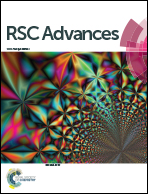Trapping a moving droplet train by bubble guidance in microfluidic networks†
Abstract
Trapping a train of moving droplets into preset positions within a microfluidic device facilitates the long-term observation of biochemical reactions inside the droplets. In this paper, a new bubble-guided trapping method, which can remarkably improve the limited narrow two-phase flow rate range of uniform trapping, was proposed by taking advantage of the unique physical property that bubbles do not coalescence with two-phase fluids and the hydrodynamic characteristic of large flow resistance of bubbles. The flow behaviors of bubble-free and bubble-guided droplet trains were compared and analyzed under the same two-phase flow rates. The experimental results show that the droplets trapped by bubble-free guided trapping exhibit the four trapping modes of sequentially uniform trapping, non-uniform trapping induced by break-up and collision, and failed trapping due to squeezing through, and the droplets exhibit the desired uniform trapping in a relatively small two-phase flow rate range. Compared with bubble-free guided droplets, bubble-guided droplets also show four trapping modes. However, the two-phase flow rate range in which uniform trapping occurs is increased significantly and the uniformity of the trapped droplet array is improved. This investigation is beneficial to enhance the applicability of microfluidic chips for storing droplets in a passive way.



 Please wait while we load your content...
Please wait while we load your content...